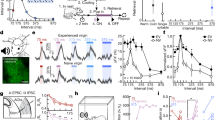Abstract
There has been a revival of interest recently in the ultrasonic calls of infant rodents as investigators are using them to assess neurobehavioral development and animal models of anxiety. We compared the rates of ultrasonic calling of infant mice of two genotypes in two situations, cold and rotation. The subjects of study were 169 mouse pups from 29 litters and of two F1 genotypes, C57BL/10J × DBA/2J and C57BL/10J × SJL/J. Half of each litter was recorded in a cool situation for 20 seconds and the other half was recorded while rotating at 10 rpm for 20 seconds. All pups were recorded on days of age 2 to 8. Rotation elicited calling at about twice the rate as cool temperature on each day of age and on average across days; situation (cold or rotation) accounted for over 50% of the variation between litters. Genotype also altered call rate, and on some days situation and genotype interacted. In studies of neurobehavioral development and the effects of pharmacological agents on infant mice, it is particularly important to understand the roles of the stimuli and genotypes employed.
Similar content being viewed by others
REFERENCES
Ammassari-Teule, M., Hoffman, H., and Rossi-Arnaud., C. (1993). Learning in inbred mice:strain-specific abilities across three radial maze problems. Behav. Genet. 23:405–412.
Barron, S., Segar, T., Yahr, J., Baseheart, B., and Willford, J. (2000). The effects of neonatal ethanol and/or cocaine exposure on isolation-induced ultrasonic vocalizations. Pharmacol. Biochem. Behav. 67:1–9.
Bell, R. W., Nitschke, W., and Zachman, T. (1972). Ultrasounds in three inbred strains of young mice. Behav. Biol. 7:805–814.
Blumberg, M. S., and Sokoloff, G. (2001). Do infant rats cry? Psychol. Rev. 108:83–95.
Branchi, I., Santucci, D., and Alleva, E. (2001) Ultrasonic vocalisation emitted by infant rodents: A tool for assessment of neurobehavioural development. Behav. Brain Res. 125:49–56.
Cohen-Salmon, C., Carlier, M., Roubertoux, P., Jouhaneau, J., Semal, C., and Paillette, M. (1985). Differences in patterns of pup care in mice. V. Pup ultrasonic emissions and pup care behavior. Physiol. Behav. 35:167–174.
Haack, B., Markl, H. and Ehret, G. (1983) Sound communication between parents and offspring. In J. Willott (ed) The Auditory Psychobiology of the Mouse. Springfield, Ill: C. C. Thomas Publisher (pp. 57–97).
Haack, M. E., Hewitt, J. K., Adams, M., and Tully, T. (1987). Genetic influences on ultrasonic vocalizations in young mice. Behav. Genet. 17:155–166.
Hahn, M. E., Hewitt, J. K., Schanz, N., Weinreb, L., and Henry, A. (1997). Genetic and developmental influences on infant mouse ultrasonic calling. I. A diallel analysis of the calls of 3-day olds. Behav. Genet. 27:133–143.
Hahn, M. E., Karkowski, L., Weinreb, L., Henry, A., and Schanz, N. (1998). Genetic and developmental influences on infant mouse ultrasonic calling. II. Developmental patterns in the calls of mice 2–12 days of age. Behav. Genet. 28:315–325.
Hahn, M. E., Benno, R. H., Schanz, N., and Phadia, E. (2000). The effects of prenatal cocaine exposure and genotype on the ultrasonic calls of infant mice. Pharmacol. Biochem. Behav. 67: 729–738.
Koch, M., and Ehret, G. (1989). Estradiol and parental experience, but not prolactin are necessary for ultrasound recognition and pup-retrieving in the mouse. Physiol. Behav. 45:771–776.
Okon, E. E. (1970a). The ultrasonic responses of albino mouse pups to tactile stimuli. J. Zool. Lond. 162:71–83.
Okon, E. E. (1970b). The effect of environmental temperature on the production of ultrasound by isolated, non-handled, albino mouse pups. J. Zool. Lond. 162:71–83.
Oliver, B., Molewijk, H. E., van der Heyden, J. A. M., van Oorschot, R., Ronken, E., Mos, J., and Miczek, K. A. (1998). Ultrasonic vocalizations in rat pups: Effects of serotonergic ligands. Neurosci. Biobehav. Rev. 23:215–227.
Panksepp, J., and Burgdorf, J. (2000). 50-kHz chirping (laughter?) in response to conditioned and unconditioned tickle-induced reward in rats: Effects of social housing and genetic variables. Behav. Brain Res. 115:25–38.
Roberts, L. H. (1975). The rodent ultrasound production mechanism. Ultrasonics 13:83–88.
Sales, G. D., and Smith, J. C. (1978). Comparative studies of the ultrasonic calls of infant murid rodents. Dev. Psychobiol. 11:595–619.
Zippelius, H. M., and Schleidt, W. M. (1956). Ultraschall-laute bej jungen mausen. Naturwissenschaften, 43:502.
Author information
Authors and Affiliations
Corresponding author
Rights and permissions
About this article
Cite this article
Hahn, M.E., Schanz, N. The Effects of Cold, Rotation, and Genotype on the Production of Ultrasonic Calls in Infant Mice. Behav Genet 32, 267–273 (2002). https://doi.org/10.1023/A:1019728813891
Issue Date:
DOI: https://doi.org/10.1023/A:1019728813891




